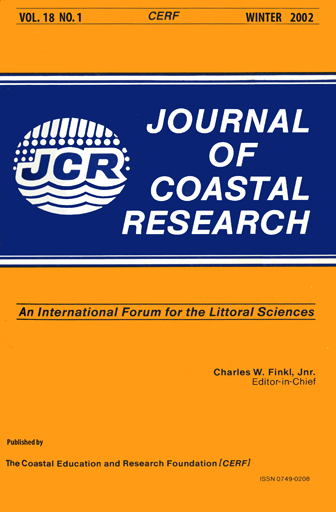Extreme Storms on the Pacific Northwest Coast during the 1997-98 EI Nino and 1998-99 La Nina
Keywords:
EI Nino, La Nina, coastal erosion, extratropical storms, storm surge, wave generationAbstract
Six major storms occurred between 1997 and 2000 offshore from the Pacific Northwest (PNW) of the United States, each generating deep-water significant wave heights greater than 10 m, the approximate height of the 100-year storm event determined from wave data collected up through 1996. Part of this apparent sudden increase in storm-wave heights was found to be associated with a progressive increase that has spanned the past 25 years (ALLAN and KOMAR, 2000), and a progressive increase in the magnitude and frequency of North Pacific cyclones since the late 1940s (GRAHAM and DIAZ, 2001), but also may have been affected by successive occurrences of a strong EI Nino (1997-98) and moderate La Nina (1998-99). The objective of this paper is to document in detail the meteorological conditions and wave generation of these recent storms, due to their unusual strengths and because they produced substantial erosion along the coast. The paper focuses primarily on the two severest storms that crossed the PNW coast; the 1920 November 1997 EI Nino storm that generated 10.5 m significant wave heights, and a storm on 2-3 March 1999 (La Nina) that produced 14.1 m significant wave heights. With the presence of several NDBC buoys close offshore, the movement of each storm can be followed as it developed, and there is good spatial documentation of the meteorological conditions and generated waves. The measured wave heights and periods are used to calculate the along-coast variations in wave runup on PNW beaches. In addition, tide gauges permit analyses of the accompanying storm surge produced by the high winds and low atmospheric pressures of the storms. The largest storm surge occurred during the strongest storm in March 1999, which produced a peak surge of 0.6 m along the Oregon coast and 1.6 m on the Washington coast. Important to the resulting coastal erosion are analyses undertaken of the total water levels reached during the storms, produced by the wave runup above and beyond the elevated tides. Analyses of the 19-20 November 1997 EI Nino storm and 2-3 March 1999 La Nina storm yielded estimated wave runup elevations that ranged from 2.8 to 4.1 m, while the total water levels (wave runup plus tides) reached 6.4 m relative to the NGVD 1929 vertical datum. These high water levels were a major cause of extreme erosion observed along the coasts of Oregon and Washington.


